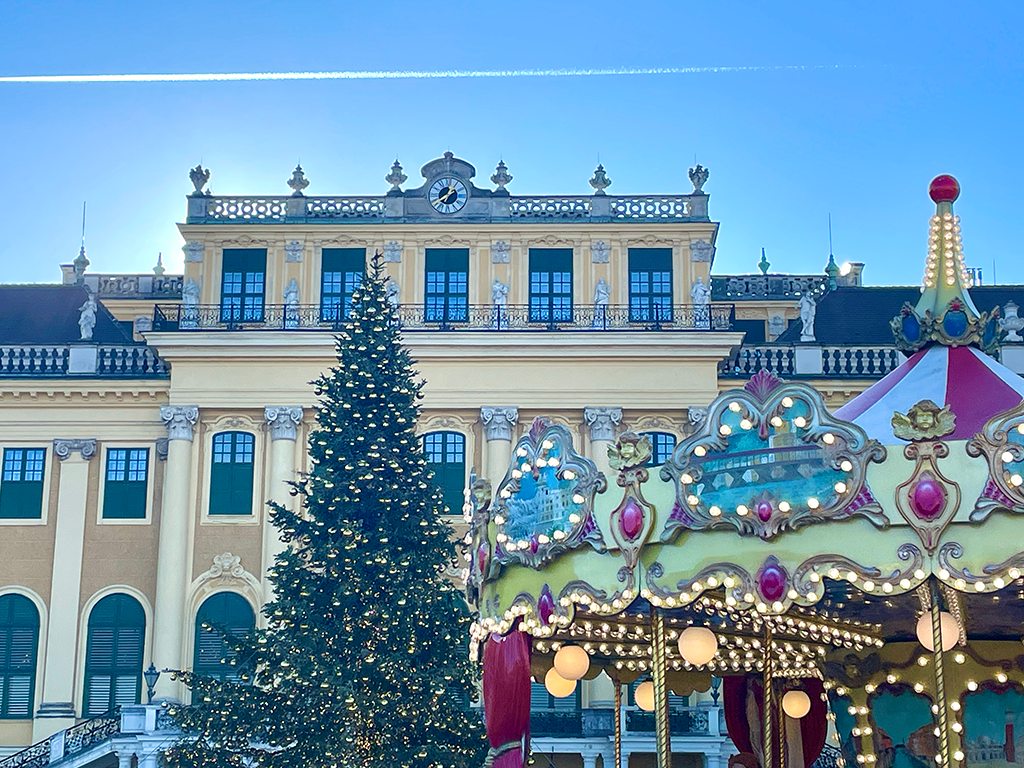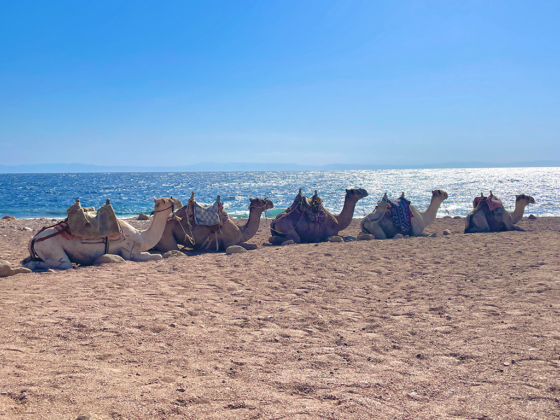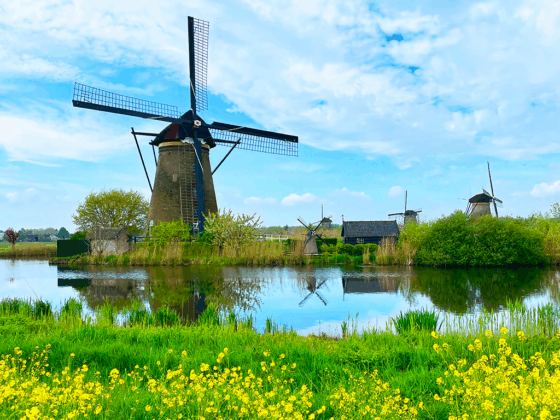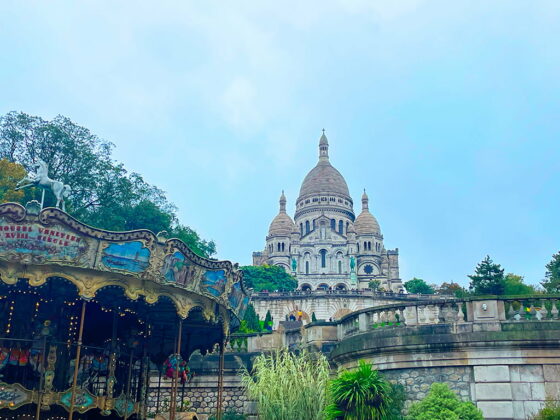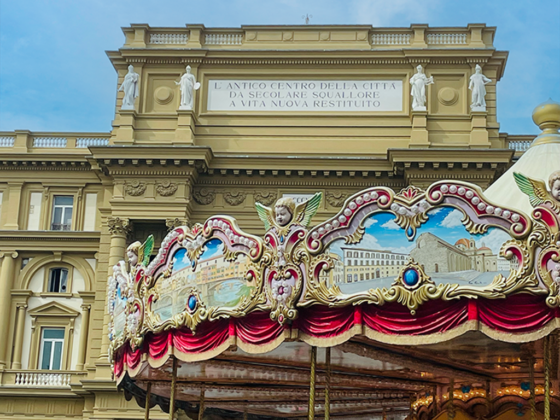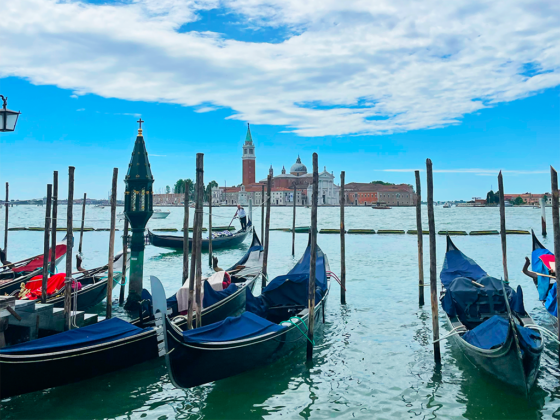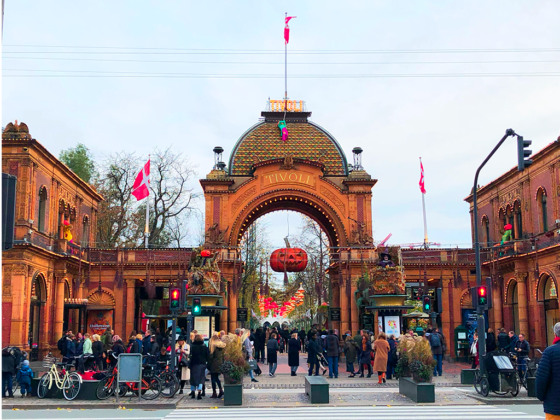Vienna, among the European capitals, has always held a special place in my heart. The first time I visited was in summer: the Belvedere Gardens in full bloom, the banks of the Danube alive with outdoor cafés and the sun shining on the facades of the imperial palaces. It was wonderful to visit in summer but I have always wanted to see it in winter too, with its Christmas markets and bright lights.
This year I decided to share the magic of Vienna with Paolino, and I planned a four-day itinerary. In this article, I will tell you about our trip, hoping to inspire you to experience the Austrian capital in a season as cold as it is enchanting.
- Map
- Travel Tips
- Day 1: Stephansdom, Ankeruhr, Sissi’s Museum, Austrian National Library, Heldenplatz e Rathausplatz
- Day 2: Schönbrunn Palace, Natural History Museum e Kunsthistorisches Museum
- Day 3: Belvedere Castle, Karlskirche, Naschmarkt, Donauturm e Prater
- Giorno 4: Hundertwasserhaus, Hundertwasser Village
Map
Travel Tips
How to get to Vienna from the airport
Vienna Airport (VIE) is well connected to the city and there are several options to suit every need and budget.
City Airport Train (CAT): this is the fastest option, arriving at Wien Mitte station, right in the centre, in just 16 minutes. It runs every 30 minutes and the ticket costs €12 one way (€21 return) and can be purchased online, from the automatic machines at the airport, or directly on the train.
ÖBB Railjet trains: still a fast but cheaper option. They connect the airport with Vienna Central Station (Wien Hauptbahnhof) in about 15-20 minutes, with stops also at Wien Meidling. Tickets cost from €4.30 and trains run every half hour.
S7 light rail: this is the cheapest option. For about €4.30 (including the airport surcharge), you get to the centre in about 25 minutes. It is a little slower than the other trains, but it is ideal for those who are not in a hurry and want to save money.
Vienna Airport Lines buses: journey times vary between 20 and 45 minutes, and tickets cost €8 (or €13 return). There are three main lines connecting the airport to different parts of the city: Schwedenplatz, in the heart of Vienna; Donauzentrum, in the northeast; Westbahnhof, the western station.
Taxis: are always available outside the airport. They take you there in about 20-30 minutes and cost between €36 and €50. This is a practical solution, especially if you are travelling with a lot of luggage or arrive late at night.
Which passes to use in Vienna
To optimise the budget, tourist passes are always a good choice. There are several options, each with specific characteristics. As always, the advice is to make a list with the attractions you want to visit, with the costs, according to the days you will be there and compare the cost of the various passes considering the attractions included.
Vienna Pass: offers free admission to over 90 sights, museums and attractions such as Schönbrunn Palace, Schönbrunn Zoo and Belvedere. It is available in versions of 1, 2, 3 or 6 consecutive days. It also includes unlimited use of Vienna Sightseeing Tours’ HOP ON HOP OFF buses for the entire duration of the pass. It does not include public transport but can be combined with a Travel Card for transport use. Please note: some attractions do not provide priority entry, you must go to the ticket office and receive your free ticket with a fixed entry time.
Vienna Flexi Pass: allows free admission to 2, 3, 4 or 5 attractions of your choice from a list of over 60 sites. The pass is valid for 60 days from the first use so it is ideal for those staying in the city longer. Again, public transport is not included, but you can add a 72-hour HOP ON HOP OFF upgrade.
Vienna City Card: focuses mainly on public transport, offering unlimited travel on buses, trams and underground for 24, 48 or 72 hours. It also includes some discounts for numerous attractions, museums, restaurants and shops.
Vienna EasyCityPass: similar to the Vienna City Card, it offers unlimited use of public transport for periods ranging from 24 hours to one week, as well as discounts for attractions and restaurants.
Day 1: Stephansdom, Ankeruhr, Sissi’s Museum, Austrian National Library, Heldenplatz e Rathausplatz
We begin our first day with a visit to the majestic Stephansdom, known for its imposing Gothic spire and its roof decorated with thousands of glazed tiles that sparkle in the sunlight, unique in the world.
We ascend the 68-metre-high North Tower via a lift. At the top is the ‘Pummerin‘, Austria’s largest bell weighing almost 21 tonnes, and you can enjoy a precious view of its magnificent multi-coloured, diamond-shaped roof made of 230,000 tiles. We then visit the catacombs that house the tombs of bishops and princes and the bones of more than 10,000 Viennese citizens. The underground corridors can only be visited on a guided tour lasting about 30 minutes. Finally we tackle the 343 steps and climb to the top of the South Tower, also known as the Watchtower, to enjoy a superb panoramic view of the city, 136 metres above the ground.
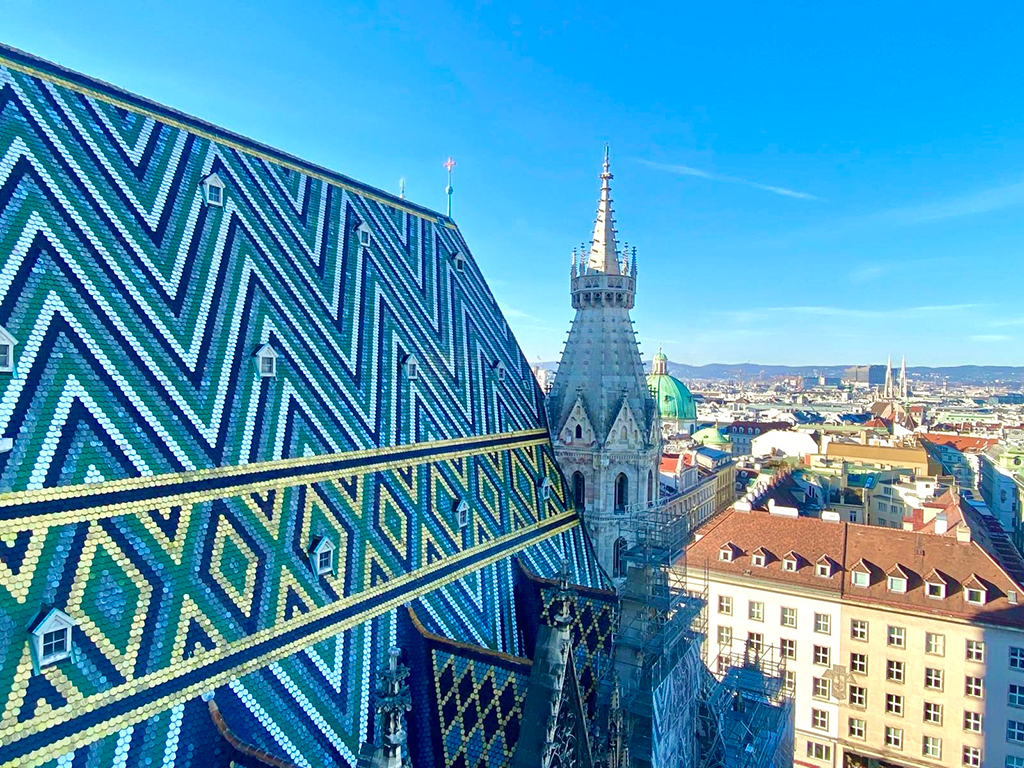
After a short walk, we arrive at theAnkeruhr, an extraordinary clock that seems to tell the city’s story with every chime. Over the course of twelve hours, as many single or paired figures from Vienna’s history move past the ancient coat of arms of Vienna.
Tips for Trips: Every day at 12 noon, you can watch the parade of all the figures with period music playing in the background. During Advent at 5 and 6 p.m., Christmas carols are performed daily.
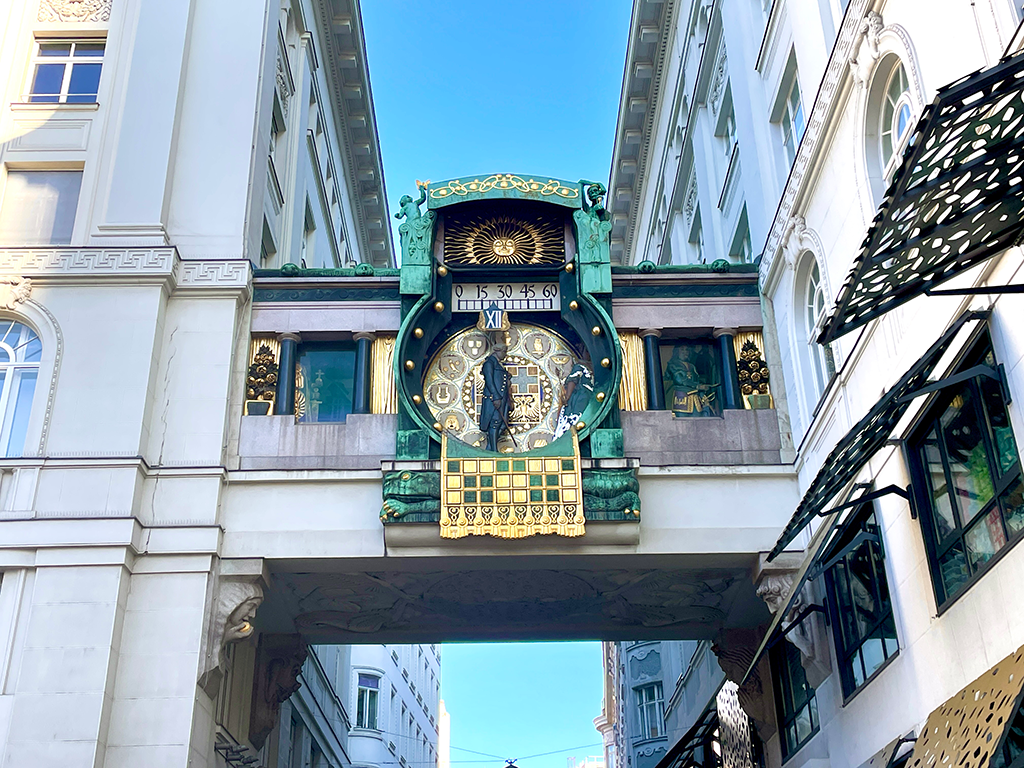
It’s time for a break, and we decide to have lunch at the famous Figlmüller, known for serving Vienna’s most famous Schnitzel. The restaurant has been an institution since 1905. We order their iconic schnitzel, thin and crispy, accompanied by a perfectly dressed potato salad. We queue for a long time, but in the end, lunch gives us a taste of true Viennese culinary tradition. Was it worth it? I don’t know, but it was worth trying!
We head into the heart of Vienna and enter the Hofburg, the residence of the Habsburgs. Our first stop is the Sissi Museum, where we learn about the fascinating and tormented life of Empress Elisabeth. We then continue on to the Imperial Apartments.
Tips for Trips: For Vienna Pass holders there is no priority entrance to the Sisi Museum. You have to go to the museum’s ticket office to get your ticket at the designated entrance time. Unfortunately it is only possible to book entry for the same or the following day, so during busy periods it is best to arrive early in the morning.
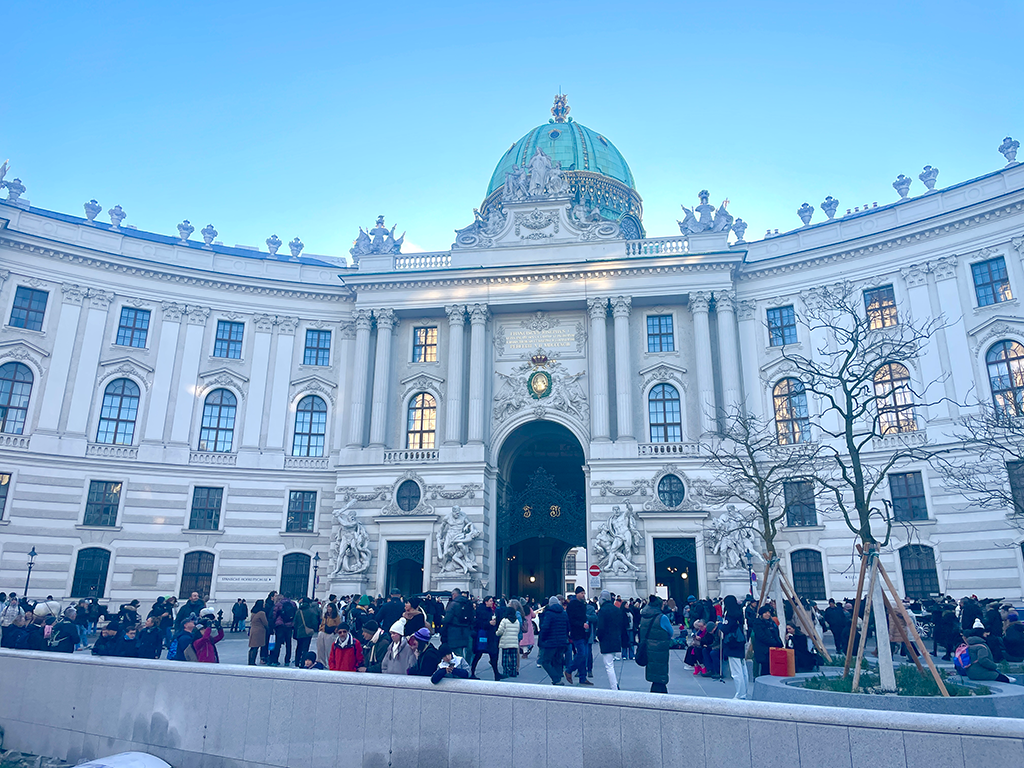
We then visit the Austrian National Library. Entering the Prunksaal is like entering a temple dedicated to knowledge. The wooden shelves, antique globes and ceiling frescoes create a unique ambience. Every detail reflects the deep love for culture and knowledge. We lose ourselves in the details, among the old books and the soft light filtering through the large windows.
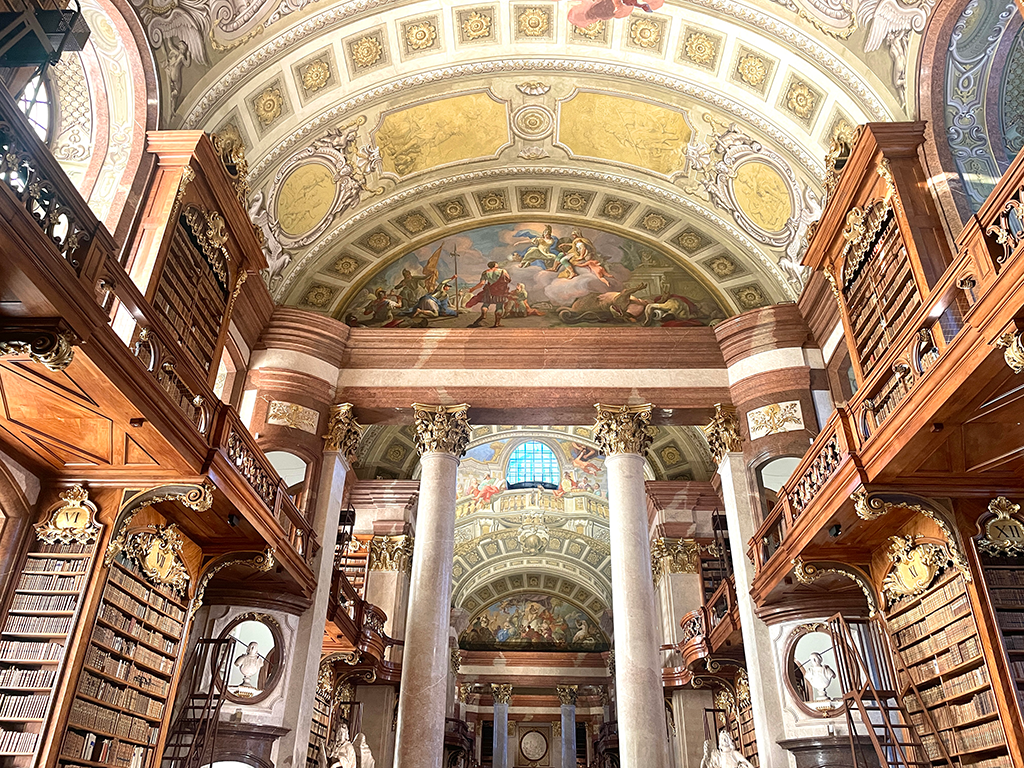
Leaving the Hofburg, we find ourselves on the monumental Heldenplatz. The equestrian statues of Archduke Charles and Prince Eugene are solemn. The place exudes a powerful force. You only have to look around to admire other splendid palaces: the Town Hall, the Parliament and the buildings housing the Natural History Museum and the Museum of Fine Arts.
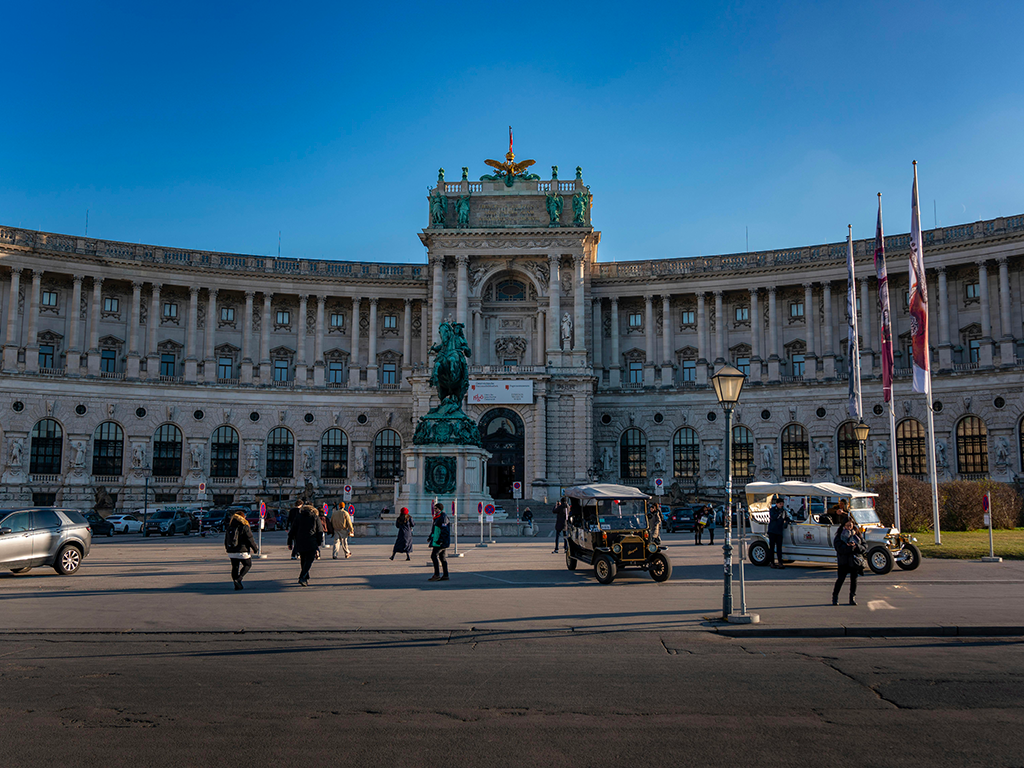
Before continuing with our itinerary, we make a stop at the legendary Café Sacher: we order the world-famous Sachertorte, the most famous chocolate cake in the world, accompanied by a glass of wine. The elegant atmosphere of the café, with its classic décor and unmistakable aroma of chocolate, gives us a moment of pure pleasure.
Tips for Trips: The queue to enter one of the three Sacher Cafés is always very long! Those who are not interested in the experience can go directly to the hotel shop and buy the cake without queuing up!
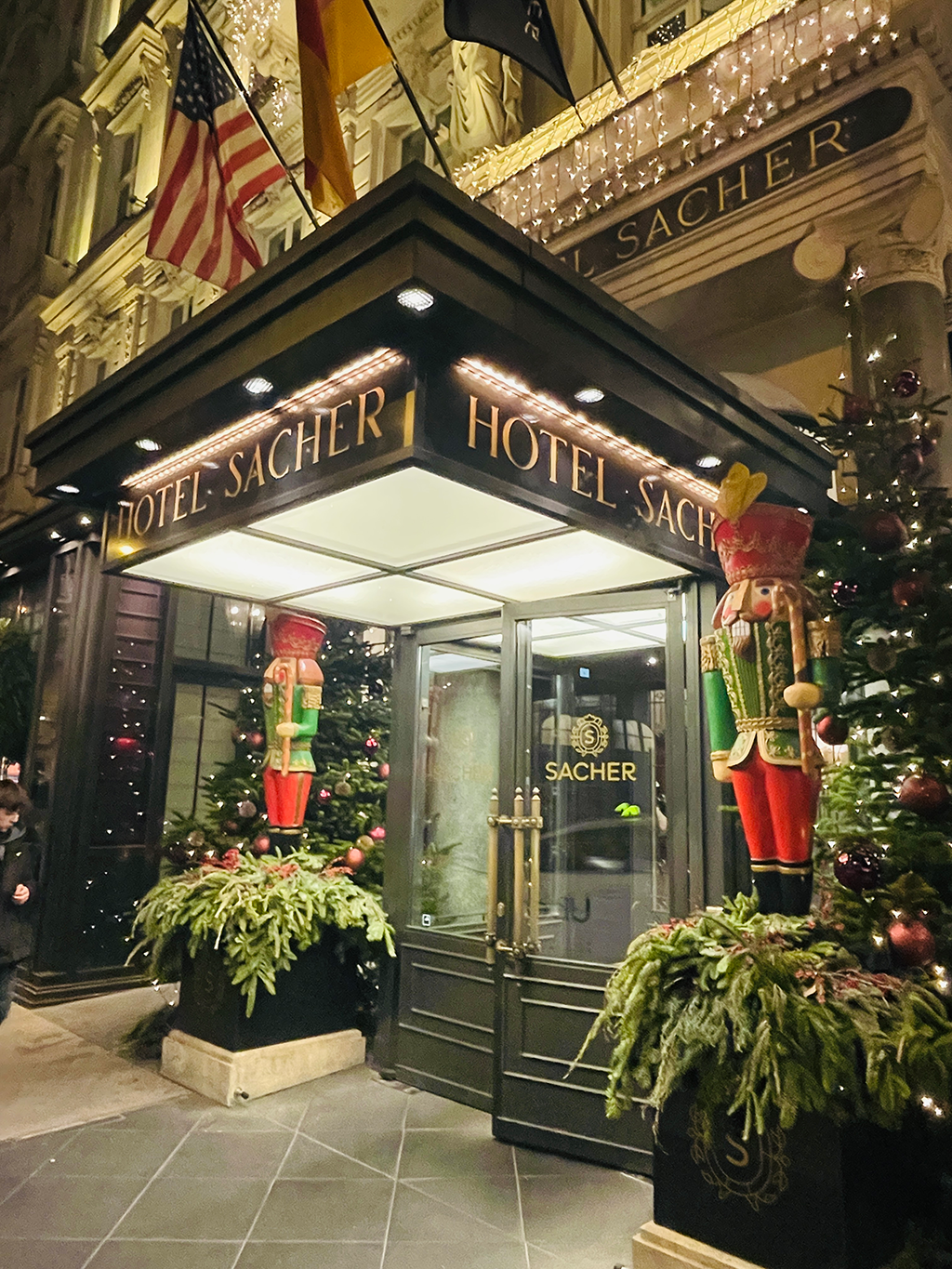
Our last stop takes us to Rathausplatz, where a dreamlike atmosphere awaits us. The Christmas markets welcome us with twinkling lights, the aromas of mulled wine, cinnamon and traditional sweets. The illuminated façade of the Rathaus provides the perfect backdrop, turning the square into a real spectacle. We end the evening with a hot cup of punch, admiring the magic that Vienna has to offer at this time of year.

Day 2: Schönbrunn Palace, Natural History Museum e Kunsthistorisches Museum
Our day begins at Schönbrunn Palace, the magnificent summer residence of the Habsburgs. We stroll through its opulent rooms, such as the Grand Gallery, decorated with breathtaking frescoes and crystal chandeliers. After exploring the interiors, we venture into the gardens, a Baroque wonder culminating in the Gloriette, a pavilion with a panoramic view of the city.
Tips for Trips: again, there is no priority entrance for Vienna Pass holders. You will therefore have to pass by the ticket office outside the palace to get your ticket with the time of your visit. We arrived early in the morning and managed to block the entrance a quarter of an hour later.
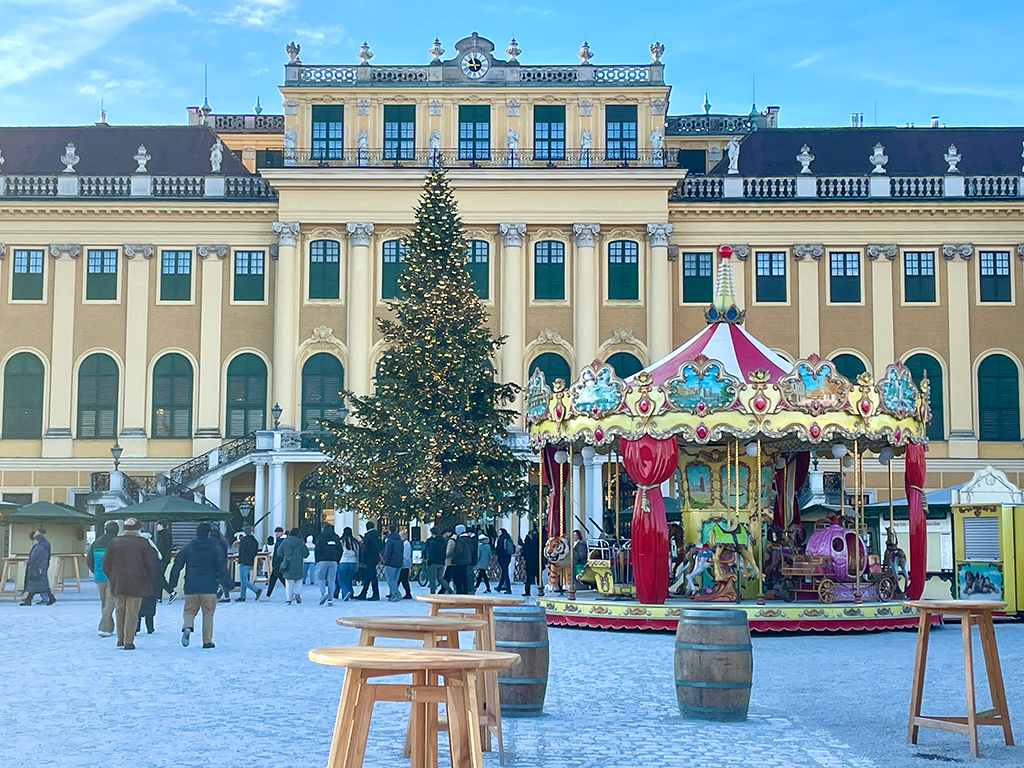
Having finished our tour of the gardens, on our way back to the palace we pass by the Schoenbrunn Zoo, admission is included in the pass so we decide to enter. We become children again, discovering a wide variety of animals, from penguins to polar bears, from koalas to lemurs to rhinos and lions.
For lunch, we stop at the Christmas market in front of Schönbrunn Palace. The square is transformed into a Christmas village, with artisan stalls and lots of food: traditional sweets and typical dishes. We eat a bratwurst accompanied by a steaming mug of mulled wine.
In the afternoon, we move towards the city centre to visit the Natural History Museum. Somehow reminiscent of the one in New York, it perhaps impresses us more with its vast collections: dinosaur fossils, precious stones and the famous Venus of Willendorf, a statuette dating back 29,500 years. What really makes the difference is the palace, as beautiful as only palaces in Vienna can be, it feels like being in a palace!

On the other side of the square is the Kunsthistorisches Museum, one of the world’s most important art museums housing works by artists such as Bruegel, Caravaggio, Rubens and Velázquez. Not only art, however: we also find the Egyptian collection and the collection of classical antiquities. Here again, the part that impressed us the most is the building itself (if possible it is even more beautiful than the previous one), with its imposing dome and opulent decoration, it is a work of art of inestimable beauty!

Our day ends at one of the oldest inns in Vienna, the Griechenbeisl, which has been in existence since the 15th century. Upon entering, we are enveloped in a cosy atmosphere steeped in history: this inn has hosted artists such as Beethoven, Mozart and Schubert. We savour an Austrian goulash accompanied by a good glass of wine.
Day 3: Belvedere Castle, Karlskirche, Naschmarkt, Donauturm e Prater
Today it is the turn of Belvedere Castle, in full Baroque style, surrounded by beautiful gardens. We begin at the Upper Belvedere, which houses a permanent exhibition of iconic works such as Judith or The Kiss by Gustav Klimt, along with masterpieces by Schiele and Kokoschka. We walk through the terraced gardens, full of fountains and sculptures, until we reach the Lower Belvedere (perhaps the part that excited us the least, perhaps because we are not particular admirers of modern art).
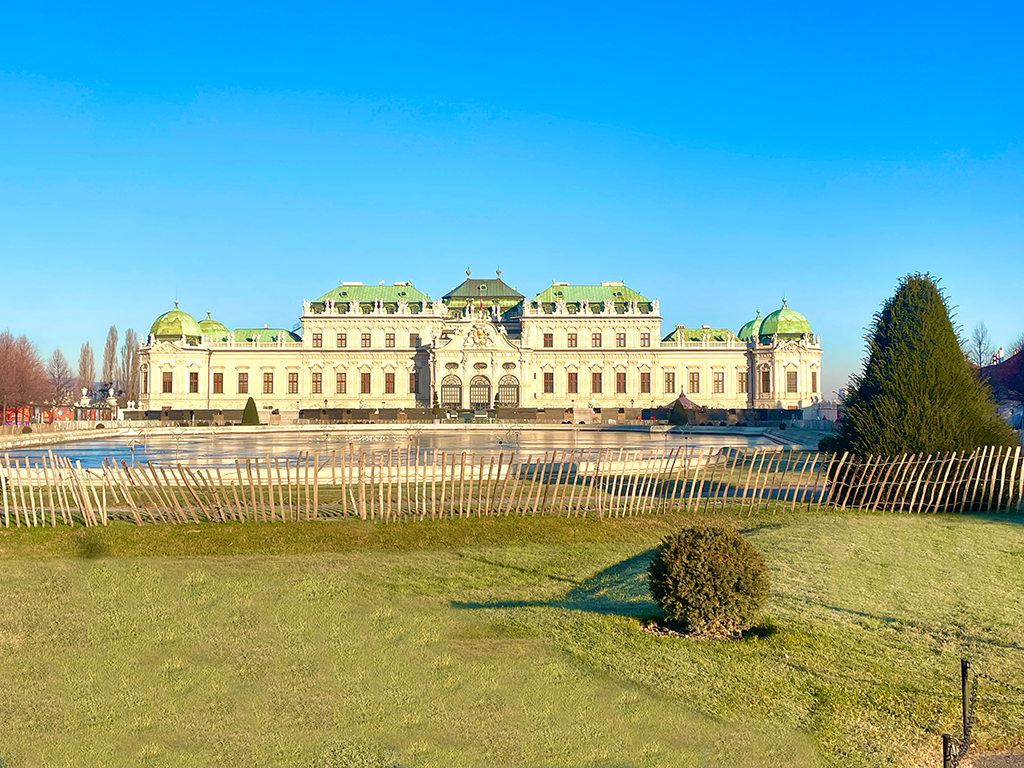
We visit the Karlskirche, one of the most beautiful churches in Vienna. This Baroque masterpiece is distinguished by its green dome and columns inspired by those of Trajan. Inside, you can climb up to the organ gallery and then further up to the viewing terrace where you have a close-up view of the beautiful columns.
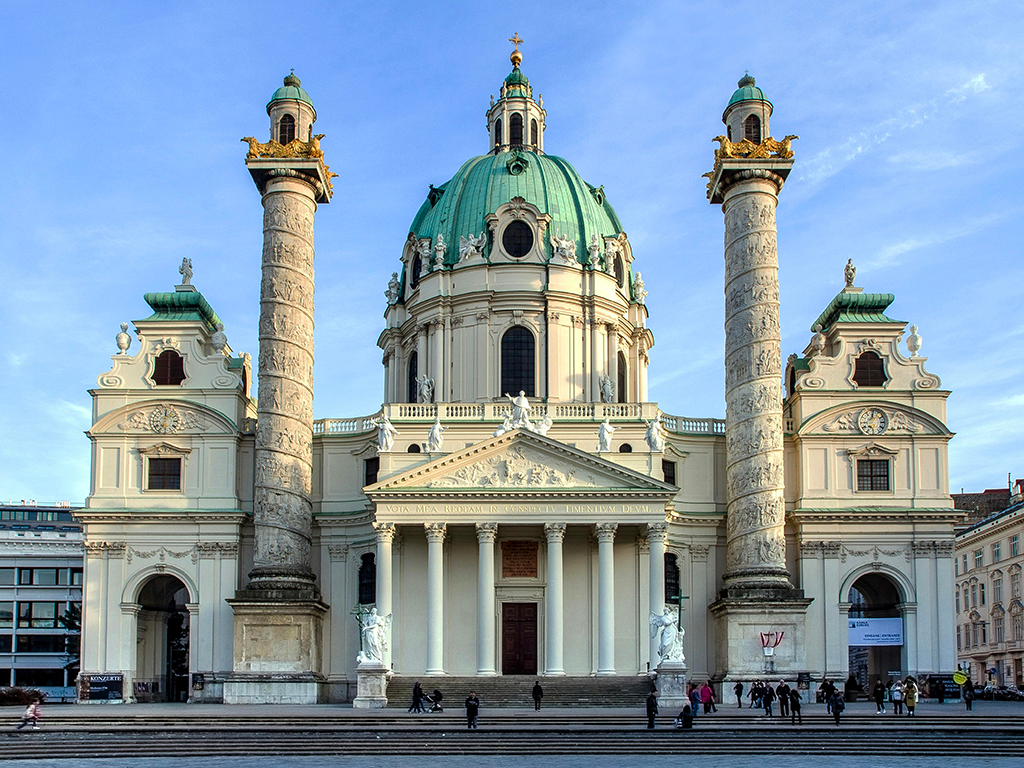
It’s time for lunch and we move on to the Naschmarkt, Vienna’s bustling food market. Among colourful stalls and inviting aromas, one can be tempted by international and local dishes. You can enjoy falafel, fresh sushi, or choose Viennese specialities like Wiener Schnitzel or a Kaiserschmarrn.
After lunch, we make an unscheduled trip requested by Paolino, who was looking forward to visiting the ‘Butterfly House’ known to most as Schmetterlinghaus, a small tropical paradise in the heart of Vienna. This greenhouse is home to hundreds of colourful butterflies fluttering among exotic plants and waterfalls.
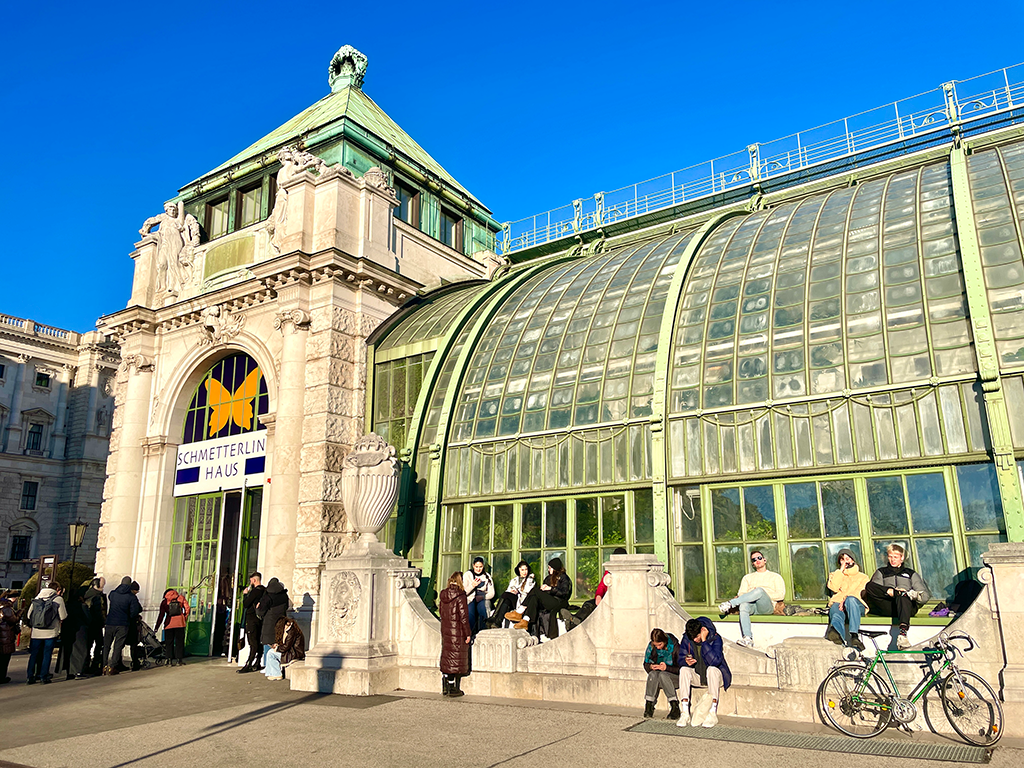
We continue to the Donauturm, an imposing tower dominating the city. We take the lift up to the viewing platform, from where we can admire Vienna from above, with the Danube flowing through the quarters. But we have another mission here: the panoramic slide that runs 165 metres high along the outer side of the tower. The slope is 29 degrees and the ride takes just under 10 seconds to reach the viewing platform, which is 15 metres below. UNFORGETTABLE!
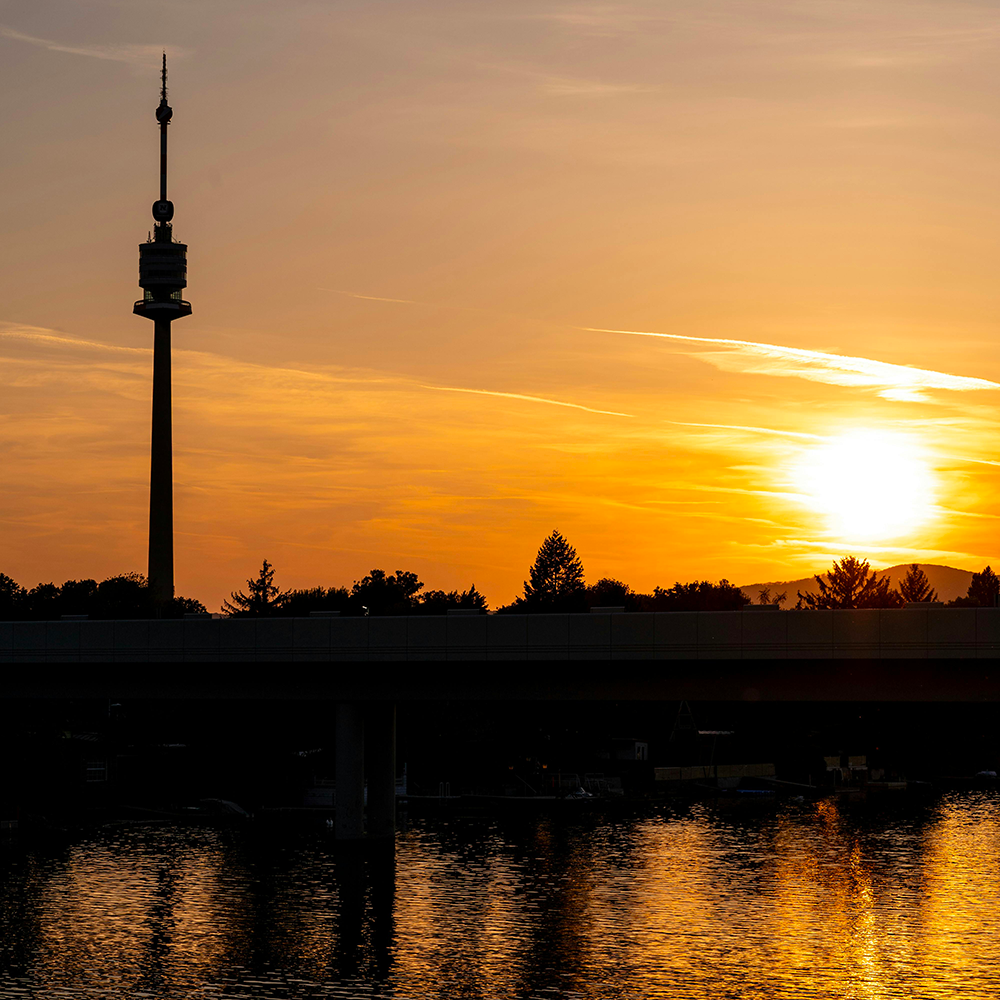
We end the day at the world-famous Prater, Vienna’s iconic amusement park. We get lost among the lights and attractions. Of course, we cannot miss a ride on the Riesenrad, the historic Ferris wheel that offers an absurd view of the illuminated city. We dine in one of the many restaurants in the park, in the warmth.

Giorno 4: Hundertwasserhaus, Hundertwasser Village
We dedicate our last morning in Vienna to the creativity of Hundertwasser.
We arrive at Hundertwasserhaus, one of Friedensreich Hundertwasser’s most famous works. This residential complex is famous for its colourful facades, irregular windows and green roofs. We admire the building from the outside, enchanted by its energy and originality: it is a true work of art.

Opposite the building is the entrance to theHundertwasser Village. This complex, which houses shops, galleries and cafés, is an ode to creativity. The colourful facades, wavy lines and use of natural materials transport us to an almost imaginary world. We stroll through the narrow streets of the village, observing its eccentric shapes and the plantings that enrich every corner. It’s a place that stimulates the imagination, it’s like going down the rabbit hole!
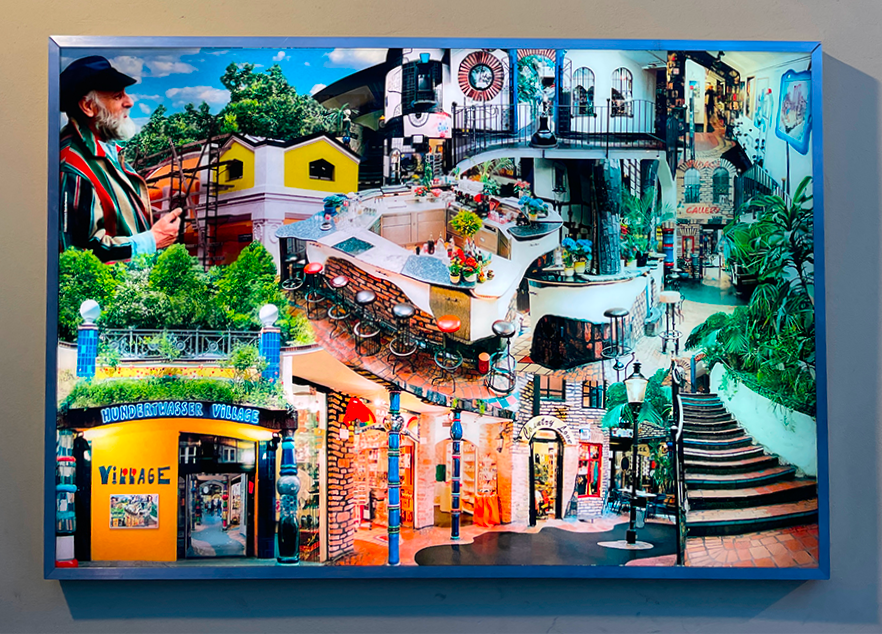
***
Paulinus writes the conclusions of this article this time so he can stop lounging on the couch.
Here it is! Unlike Franky I had never been to Vienna. For years I grew up with the myth of ‘Vienna is the most beautiful city in Europe’ and I finally had the chance to see for myself that if it is not the most beautiful, it is very close. Obviously everyone can have different tastes, but every building is a work of art, every tile seems hand-cleaned and everything looks white and bright even on grey winter days. And then there was the Butterfly House. Never have I seen such large and colourful butterflies. For about an hour I hoped a butterfly would land on me just to take a picture with it, but they preferred to nest in another guy’s hipster beard. Lucky him… And if you go to the Prater, don’t listen to people like Franky Lou. The mouse carousel is bloody scary. It’s much worse than our Brucomela in Gardaland. I lost all my manhood on that merry-go-round. In conclusion, though, it was a beautiful ride.
Last modified: 19 June 2025
